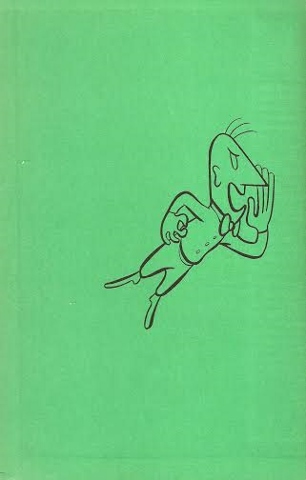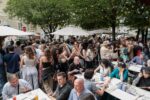c/o – an alternate correspondence #3

1/9unosunove è lieta di presentare Benjamin Tiven c/o Per-Oskar Leu – an alternate correspondence, il terzo episodio del ciclo di mostre curato da Marianne Derrien.
Comunicato stampa
1/9unosunove è lieta di presentare Benjamin Tiven c/o Per-Oskar Leu – an alternate correspondence, il terzo episodio del ciclo di mostre curato da Marianne Derrien. Il dialogo e la corrispondenza tra Per-Oskar Leu (Norvegia, 1980) e Benjamin Tiven (USA, 1978) ha inizio due anni fa, dal loro incontro a New York durante l’Independent Study Program del Whitney Museum e pubblicando i propri progetti di ricerca multimediale sulla rivista online Triple Canopy.
La mostra esamina alcune delle ricadute estetiche e culturali successive ai periodi di crisi politica. Ri-articolando immagini, illustrazioni, archivi e documenti, Leu e Tiven trovano il loro punto di ancoraggio nel fenomeno primordiale (ur-phenomenon) dell’animazione, e nell'interazione tra forme naturali e strumenti tecnici. La loro corrispondenza alternata è strutturata sulla base di vari riferimenti alla figura dell'asino: utilizzata nel 1940 da Bertolt Brecht e dalla Walt Disney (nel suo famoso cartone animato Pinocchio), e negli ultimi anni sia come arma di guerra asimmetrica sia come elemento dell’immaginario militare avanzato.
Benjamin Tiven vive a Brooklyn e lavora con il video, la fotografia e la scrittura. I suoi nuovi lavori discutono la trasformazione delle forme sotto la pressione delle ideologie divergenti e della sorveglianza persistente. Two devices è una narrazione video che immagina la vita interiore di due animali: un prototipo di gabbiano robot e un asino carico di esplosivo. Attraverso queste figure, Tiven esplora un lessico sviluppato dall'esercito americano per i suoi macchinari automatizzati e le ambizioni corporative apparentemente benigne che si celano dietro l’uccello autonomo meccanico.
Il filosofo Grégoire Chamayou, nella sua Teoria del Drone, collega lo sviluppo delle armi autonome a quelle precedenti presenti nel cinema Hollywoodiano. Come nuovo meccanismo di individuazione degli obiettivi, il drone sembra essere il simbolo dell’artificialità, nato sotto il segno delle false apparenze di Hollywood. In quanto tale, riportando nuovamente le armi autonome nello spazio della narrazione video, Tiven mappa le proprie traiettorie di sviluppo su questi oggetti, fondendoli con dati spaziali e temporali. Una corrispondente serie di fotografie mostra l’arredamento tecnico di uno studio di animazione chroma key e un insieme di oggetti liminali destinati a funzionare in ambienti digitali. Altre due opere analizzano la capacità dell'architettura di deformare o impedire protocolli di produzione delle immagini spaziali della modernità. War Architecture consiste di due fotografie della cappella di Paul Virilio e Claude Parent a Nevers, in Francia, che riprende le forme dei bunker militari costieri della Seconda Guerra Mondiale. Le sculture Invisible Encampment, una serie di oggetti in plastica stampati in 3D, propongono la ripetizione e la duplicazione come meccanismi per affossare la sorveglianza aerea.
I nuovi lavori di Per-Oskar Leu, dal titolo In Praise of Learning, riguardano la lotta per l’ideologia nel settore dello spettacolo di massa: in particolare, i tentativi di Hollywood di depoliticizzare i film americani degli anni Quaranta e Cinquanta. In Praise of Learning deriva da una poesia del poeta e drammaturgo tedesco Bertolt Brecht che trascorse gli anni della guerra in esilio come sceneggiatore a Hollywood, prima di essere chiamato davanti alla Commissione delle Attività Antiamericane (HCUA) come testimone "ostile". L’opera consiste di un giornale murale - un mezzo di diffusione delle informazioni comunemente associato con la Russia Sovietica. Diciotto flip books sono montati con leganti in acciaio su sei pannelli di legno; le pagine provengono dai numeri del New York Times pubblicati tra il 1940 e il 1947. Una serie di 48 immagini fisse dal film d'animazione della Walt Disney Pinocchio sono state trasferite sulle pagine dei giornali d'epoca con pennarello rosso. In Praise of Learning contiene la storia del coinvolgimento di Walt Disney nella caccia alle streghe contro i cosiddetti "elementi sovversivi", nel mondo dello spettacolo americano all'alba della Guerra Fredda. Il lavoro tenta di tracciare una linea evolutiva dal lancio di Pinocchio alla censura nella vita culturale americana.
La mostra è accompagnata da un saggio dello storico dell'arte Philip Glahn, specialista di Brecht, con cui Tiven e Leu hanno sviluppato nel tempo un dialogo collaborativo. Il testo tratta delle dimensioni tecniche, sociali, e estetiche della storia e in occasione della mostra, sarà presentato nella forma di un poster.
Marianne Derrien. Nata nel 1981 a Berlino, curatrice e critico d’arte residente a Parigi, Marianne Derrien ha lavorato presso la galleria Serge Le Borgne a Parigi ed è stata Addetta per le mostre all’Accademia di Francia a Roma – Villa Medici. Attualmente è capo-redattrice del sito internet e coordinatrice del Point Perché by The Absolut Company, nuovo spazio del Palais de Tokyo a Parigi. La sua pratica curatoriale si concentra sull’analisi contestuale di un territorio e della sua storia sociale, politica e sociologica attraverso le testimonianze / confessioni / micro-storie, la mentalità e il linguaggio del corpo nell’ambito di un contesto privato o politico.
English version
Thursday, November 27, 2014 - 7pm
1/9unosunove
is pleased to announce the opening of
Benjamin Tiven
c/o
Per-Oskar Leu
a show part of the cycle
c/o - an alternate correspondence
curated by Marianne Derrien
1/9unosunove is thrilled to present Benjamin Tiven c/o Per-Oskar Leu – an alternate correspondence, the third exhibition in the cycle curated by Marianne Derrien. The dialogue and correspondence between Leu (Norway, 1980) and Tiven (USA, 1978) actually began 2 years ago, when they met through the Whitney Independent Study program and the online magazine Triple Canopy, where each of them has published multi-media research projects. The exhibition they have conceived at 1/9unosunove examines some of the aesthetic and cultural fallout after periods of political crisis. Re-articulating images, illustrations, archives and documents, Leu and Tiven find their anchor point in the ur-phenomenon of animation, and in the interplay between natural forms and technical instruments. Their alternate correspondence is structured through various references that cohere in the figure of the donkey: used in the 1940s by both Bertolt Brecht and Walt Disney (in his famed Pinnocchio), and surfacing again in recent years as both a weapon of asymmetric warfare and an image of the advanced military imaginary.
Benjamin Tiven is a Brooklyn-based artist who works with video, photography and writing. Tiven's new works question the transformation of forms under the pressure of divergent ideologies and persistent surveillance. Two Devices is a narrated video imagining the inner lives of two animals: a prototype robotic seagull and an explosive-laden donkey. Through these figures, the work examines a lexicon developed by the American military for its automated machinery, and the ostensibly benign corporate ambitions behind the autonomous mechanical bird. The philosopher Grégoire Chamayou, in his book Theory of the Drone, connects the development of autonomous weapons to precedents in Hollywood cinema. As a new mechanism for improved targeting, the drone seems to be born under the sign of Hollywood’s false appearances, or the symbol of artificiality . As such, by importing them back into the space of narrative video, Tiven maps their own developmental trajectories back onto these objects, fusing them with spatial and temporal data. A related series of photographs shows the technical furniture of a chromakey animation studio; a set of liminal objects designed to function in a digital environment. Two other works deal with architecture's capacity to warp or impede modernity's spatial imaging protocols. War Architecture is a set of two photographs of Paul Virilio and Claude Parent's chapel in Nevers, France, based on the design of coastal military bunkers in the Second World War. The sculpture suite Invisible Encampment, a set of 3D-printed plastic objects, proposes repetition and duplication as mechanisms to scuttle aerial surveillance.
Per-Oskar Leu's new body of work, In Praise of Learning, looks at the struggle over ideology in the mass entertainment industry: specifically, the attempts by Hollywood to depoliticize American film during the 1940s and '50s. The title In Praise of Learning is taken from a poem by the German poet and dramatist Bertolt Brecht, who spent the war years in exile, as a screenwriter in Hollywood, before being summoned to testify before the House Un-American Activities Committee as an "unfriendly" witness. The piece takes the form of wall newspapers – a means of disseminating information commonly associated with the early Soviet Union. Onto six wooden panels are mounted a total of 18 "flip books", hung from steel binders. The pages of the flip books are taken from issues of the New York Times, dating from 1940 to 1947. A series of 48 consecutive still images from Walt Disney's 1940 animated feature film Pinocchio, have been transposed onto the vintage newspaper pages using red marker pen. In Praise of Learning contains the story of Walt Disney's involvement in the witch-hunt against so-called "subversive elements" in the American entertainment business at the dawn of the Cold War. The piece attempts to trace a historical line from the release of Pinocchio to censorship in American cultural life.
The exhibition also includes an essay by the Philadelphia-based art historian Philip Glahn, a specialist on Brecht, with whom Tiven and Leu have been in collaborative dialog. The text deals with the technical, social, and aesthetic dimensions of history, and is presented here in a gallery poster.
Marianne Derrien. Born in 1981 in Berlin, independent curator and art critic based in Paris, Marianne Derrien worked as assistant at Serge Le Borgne 's gallery - Paris and was Project Manager for the exhibitions at the French Academy in Rome – Villa Médicis. Currently, she is editor-in-chief of the web site and coordinator of le Point Perché by The Absolut Company, new space in the Palais de Tokyo, Paris. Her curatorial practice is structured by the contextual analysis of a territory and its social, political and sociological history through testimonies / confessions / micro-history, mind control, body language within a personal or political context.



